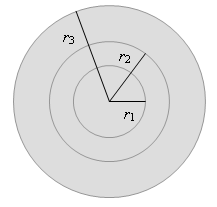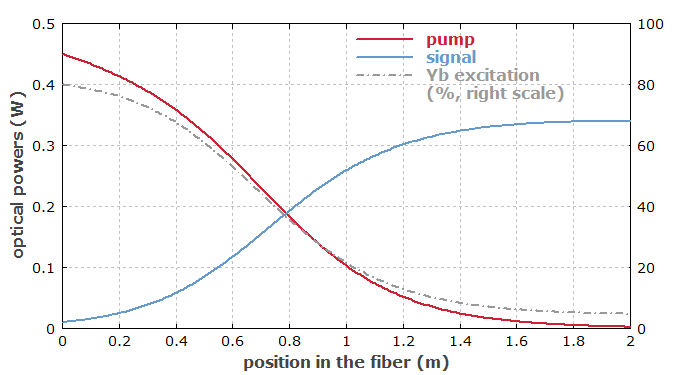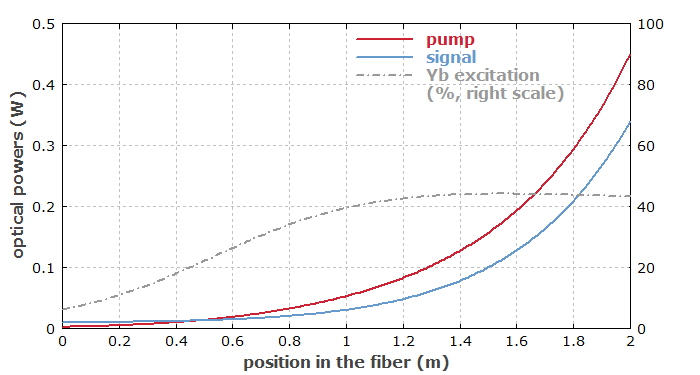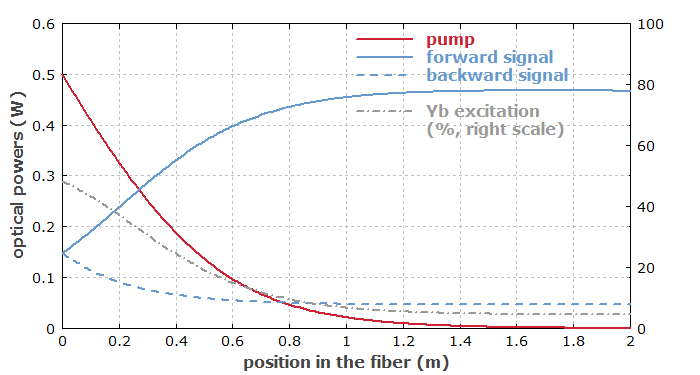Modeling of Fiber Amplifiers and Lasers
This is part 5 of a tutorial on modeling of fiber amplifiers and lasers from Dr. Paschotta. The tutorial has the following parts:
1: Introduction, 2: Optical channels, 3: Power propagation or field propagation, 4: The laser-active ions, 5: Continuous-wave operation of amplifiers and lasers, 6: Amplifying and generating short pulses, 7: Ultrashort pulses, 8: Using home-made software or a commercial product?
Part 5: Continuous-wave Operation of Amplifiers and Lasers
In this section, you will learn how to calculate the optical powers occurring during continuous-wave operation of fiber amplifiers and lasers in their steady state. We will always propagate only optical powers, not whole fields (see section 3) in order to avoid all the complications of numerical beam propagation and the correspondingly more difficult boundary conditions. Fortunately, this approach is often quite realistic, as the guiding properties of the fiber lead to more or less constant intensity profiles along the fiber.
This section contains some relatively tricky operations. Keep in mind, however, that you need to deal with those only if you develop a simulation software yourself. When using some existing software, you may simply enjoy getting the solutions.
Let us first recall from section 3 the differential equation for the optical power of a certain optical channel:
The local gain gj(z) depends on the excitation levels of the laser-active ions, which themselves can depend on the optical intensities related to all the optical channels. Therefore, we need to find a self-consistent solution for the optical powers and level excitations along the whole fiber.
Equations for ASE must contain one more terms related to spontaneous emission – but of course only that small part of the emitted power which remains guided in the fiber core. For a single-mode fiber and a four-level gain system, it turns out that only the local gain and the optical channel's bandwidth are relevant for the added power. A purely geometric reasoning, based on a limited angular acceptance range is defined by the numerical aperture of the fiber, turns out to be appropriate only for highly multimode fibers. You can find more on this in a blog article on ASE.
Calculating the Local Gain
Before looking into solutions of these equations, let us discuss how to calculate the local gain gj(z) from given optical powers of the channels. In the simplest kind of model based on top-hat intensity profiles, the intensity corresponding to an optical channel can be calculated as the power divided by the core area. For arbitrary intensity profiles, the procedure is a bit more complicated:

- Assuming that there is only a radial (but not azimuthal) dependence of the intensity, we can mathematically divide the fiber core into some set of rings (see Figure 1), i.e., regions with certain ranges of the radial coordinate within which the intensity does not vary that much. (If there is also an azimuthal dependence, we also have to divide the rings into angular sections. In case of a non-symmetric waveguide, a rectangular grid may be more appropriate.)
- For each ring, the given optical power can be divided by the ring's area to obtain the intensity.
- Using the rate equations, we can now calculate the fractional excitations of all relevant levels for each ring from the intensities.
- From the fractional excitations, we obtain the gain coefficient within each ring. Different transitions may contribute to it, as far as they have non-zero transition cross sections at the wavelength of the optical channel. Each contribution contains the product of the doping density, the fractional excitation of a level and the transition cross section.
- The total gain at the given z position is obtained as the sum of contributions from all the rings. The higher the optical intensity in a certain ring and the larger its area is, the higher is its contribution to the total gain. This means that the total gain is a kind of weighted average over the gain values in all the rings.
Solving the Propagation Equations for Amplifiers and Lasers
Now we think about how to find the self-consistent solution for the optical powers and level excitations. In general, this is rather difficult, but in simpler cases it can be done easily.
In the easiest case, all light propagates only in one direction – for example, pump and signal light in a copropagating fiber amplifier. Here, one can proceed as follows:
- At the input end of the fiber, all optical powers and thus also the intensities are known already. From these, one can calculate the local gain values (or absorption, for the pump wave), and from these the derivatives of the powers with respect to z.
- With these data, one can propagate the powers over some small distance into the fiber in order to obtain the optical powers at that point. Again, one can calculate the level excitations, gain and power derivatives.
- One simply iterates this procedure until one reaches the output end.
Effectively, we are dealing with a simple initial value problem. Figure 2 shows the results from an example case. Here, the pump power decreases due to pump absorption, whereas the signal power rises. Note that the decay of pump power is not an exponential decay, because we have substantial saturation effects. That is very common in fiber devices, which are typically operated at very high intensity levels. One of the consequences of that is that the required fiber length for an amplifier can be far longer than one would expect based on a single estimate ignoring saturation effects.

For an amplifier with counter-propagating pump and signal, the explained method cannot be directly applied, because at each end we know only one of the powers (signal or pump). However, there is a relatively simple extension of the algorithm:
- Start at the signal input end and use an estimated value for the remaining pump power at this point.
- Propagate both fields to the other end. The pump power will grow in that direction, as it is backward-propagating.
- Compare the resulting pump power at the signal output end with the actual pump input power, and on that basis correct your estimate for the remaining pump power at the signal input end.
With a few iterations, you can find the self-consistent solution. The required numerical procedure is simple; essentially, one is dealing with a one-dimensional root finding problem.
Figure 3 shows the results from an example case – same as for Figure 2, except that the pump wave now travels from right to left. By the way, one can show that the residual pump power (as well as the signal gain) must be the same as in the previous case, as long as ASE is not relevant. So in that case one could actually have avoided the iteration, just taking the residual pump power from the case with co-propagating waves.
Despite the same output powers in both cases, the distribution of the ytterbium excitation along the fiber is very different. For that reason, ASE output powers can also be very different between forward and backward direction.

Further extending that method for including amplified spontaneous emission (ASE) as well is not easy, unfortunately. The challenge is that one obtains a multidimensional root finding problem, which is substantially more difficult. The strong exponential dependencies in a high-gain system don't exactly make it easier …
For a fiber laser resonator, however, the required extension of the method is not difficult. Here, we can start at the pump input end with an estimated value of the forward signal power at that point. We then propagate pump, forward and backward signal powers to the other end. The relation of forward and backward signal power in conjunction with the reflectivity for the signal wave at that end tells us whether the used estimate was too high or too low.
Figure 4 shows results from an example case. For the signal power of 148 mW at the left end, the signal powers at the right end are consistent with the chosen output coupler reflectivity of 10%.

As fiber lasers usually have a not that high signal gain, ASE (or at least its influence on the level excitations) can usually be neglected.
Other Algorithms
Unfortunately, the explained relatively easy mathematical tricks are not always suitable due to the difficult multidimensional root finding in case of multiple counterpropagating waves. Therefore, other algorithms have been developed – in particular, relaxation techniques. Here, the basic idea is to start with an estimated distribution of level excitations and propagate all optical powers based on these. Thereafter, one recalculates the level excitations based on the obtained optical powers. Repeating these steps, one will hopefully get to the solution.
As each wave can be numerically propagated in its real propagation direction, one does not need to use estimated starting values any more. In a laser model, for example, the starting values for the signal powers in both directions are also not known from the beginning, but one can always use the value resulting from the last iteration.
However, it is again difficult to implement an algorithm which reliably converges to the solution. Often, one applies some kind of damping mechanism in order to achieve convergence. That, however, can make the convergence quite slow.
It may be reasonably easy to manually adjust the numerical parameters of an algorithm such that it converges in one given case. It is far more difficult, however, to develop an algorithm which reliably and efficiently converges in all cases. Note that the cases which can be encountered in practice can be very diverse, involving different device configurations, different spectroscopic data, different intensity regimes, etc. Lasers present special difficulties, e.g. because small errors in the gain can lead to substantial drifts of the signal powers away from the solution.
For our product RP Fiber Power, we have developed a quite sophisticated algorithm based on the general idea of relaxation methods. It further uses various numerical tricks which are based on physical insight. (When using some all-purpose numerical libraries, one could not profit from such kind of specialized ideas!) It took rather serious efforts and substantial time to develop this to a point where it works very well in a wide range of test cases. The algorithm now works very efficiently, finding the solution within quite little computation time. Also, it is quite long ago that a customer presented a case where convergence was not achieved.
Students may want to try themselves to implement an algorithm which can at least handle the simpler cases. However, be warned that a lot of hard work is required to obtain a stable and efficient all-purpose solution.
Calculating the Laser Wavelength
In the discussion on fiber lasers, we have so far implicitly assumed that the laser wavelength is already known: a given parameter of the corresponding optical channels. That is not always the case, however. Some laser resonators do not contain a strongly wavelength-selective element (e.g., a fiber Bragg grating) which determines the emission wavelength. The laser can then select the emission wavelength itself. How can be addressed that aspect in a model?
Let us first consider the involved physics. When the laser is pumped, the excitation of the laser-active ions rises until the laser reaches the laser threshold. That will be the case when the net round-trip gain becomes 0 dB at some wavelength. That wavelength will be the final emission wavelength: light at any other wavelengths, having a lower net round-trip-trip gain (i.e., less than 0 dB) has no chance to come up with any substantial power. Note that the resulting emission wavelength will often depend on the length of fiber and on the resonator losses, because in quasi-three-level laser transitions, as are typically encountered in active fibers, the shape of the gain spectrum depends on the degree of excitation.
At conceptually simple approach would be to construct a model containing a large set of optical channels with different wavelengths where lasing might occur. The computer model should then produce the correct result – lasing only on the optical channels (forward and backward direction) having the highest net gain. That is not numerically efficient, however, and also may not produce exactly the correct wavelength, since we always need to work with a limited set of wavelengths.
An alternative approach, which is more efficient and accurate, uses only a single pair of optical channels for a certain laser wavelength. For each setting of that wavelength, one can calculate the average degree of excitation of the laser-active ions – of course, after setting the end reflectivities corresponding to the chosen wavelength. One can then numerically vary that wavelength until the average excitation reaches its minimum. Such an algorithm can be easily implemented with a flexible simulation software such as RP Fiber Power.
Go to Part 6: Amplifying and Generating Short Pulses, or back to the start page.
Questions and Comments from Users
Here you can submit questions and comments. As far as they get accepted by the author, they will appear above this paragraph together with the author’s answer. The author will decide on acceptance based on certain criteria. Essentially, the issue must be of sufficiently broad interest.
Please do not enter personal data here; we would otherwise delete it soon. (See also our privacy declaration.) If you wish to receive personal feedback or consultancy from the author, please contact him e.g. via e-mail.
By submitting the information, you give your consent to the potential publication of your inputs on our website according to our rules. (If you later retract your consent, we will delete those inputs.) As your inputs are first reviewed by the author, they may be published with some delay.



These sharing buttons are implemented in a privacy-friendly way!



